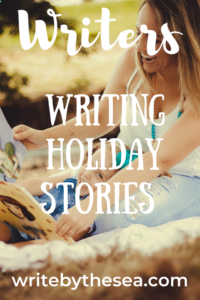A Guest Post from Children’s Author Melissa Abramovitz

Writing about Holidays
Happy February!
Like most months of the year, February has a well-known holiday—Valentine’s Day.
So what does this have to do with writing for children?
A Never-Ending Source of Ideas
Holidays provide a never-ending source of fiction and nonfiction story ideas, and since holidays recur annually, many children’s magazine and book editors have an ongoing need for stories about well-known and less-well-known holidays.
However, editors receive tons of holiday-related stories they can’t use because the main themes or messages appear over and over and over again.
As in Christmas stories in which the main character learns that being with family is more important than getting presents.
So the key to writing and getting holiday stories published is coming up with a fresh approach that hasn’t been used in thousands of other stories.
My Valentine’s Day Story
I’ve had several holiday-related stories published in childrens’ magazines over the years, some fiction and some nonfiction.
All of them were unique because I looked beyond the usual trappings of these holidays and explored questions and ideas that allowed me to put a fresh spin on the topic.
For instance, Boys’ Life magazine published my short nonfiction article titled “Be Mine” in the February 2018 issue.
But rather than discussing the hottest Valentine’s Day gifts for a special someone, the history of the Valentine’s Day holiday, or the anguish that comes from classmates not giving Valentine cards to a particular student, “Be Mine” is about the fascinating ways in which some bird species flirt and choose a partner.
Various types of male birds impress females by performing aerobatic flips, singing and dancing, “shopping” for days for the perfect betrothal stone, applying makeup to brighten their feather colors, or building elaborate homesteads.
This topic is not directly related to the Valentine’s Day holiday, but I made it relevant by suggesting in my query letter to the editor that the article could be published in the magazine’s February issue.
I also explained why I thought Boys’ Life readers would be interested in the article, “even though boys don’t usually admit to being as interested in romance as girls are,” and I included brief sample paragraphs to show how I intended to relate these birds’ behaviors to comparable human courting behaviors like giving gifts or showing off one’s fancy sportscar.
It ended up being a fun and educational piece that put a unique spin on Valentine’s Day.
Holidays In August – Or Not
Another nonfiction holiday story I did (this one in the 1990s) was unique because it started with an observation and a question about the seeming lack of any holidays in August.
I got the idea for the article one day while looking at my pocket calendar and noticing that every month except August contained pre-printed mentions of certain holidays.
So I wondered whether there really weren’t any holidays in August, and I realized that kids would also be interested in finding out the answer to this question if I shared my observation with them.
My research showed that while there are no major national holidays in the United States in August, there are August holidays in other countries, and there are also several unofficial commemorative “awareness” days like Women’s Equality Day and National Family Day in August in the U.S.
In the article, titled “Are There Any Holidays In August?”, I included information about the August holidays celebrated in various countries, as well as a bit about these commemorative days in the U.S.
In this case, a question I raised about a mundane observation led to a unique article about holidays that was published in AIM magazine.
Other Holiday Stories
Other holiday stories I’ve had published grew out of my own religious background—I’m Jewish, and therefore have first-hand knowledge about Jewish holidays like Hannukah and Passover.
In one fictional story I wrote for preschool and kindergarten-aged kids, I used my personal knowledge about a tasty traditional Hannukah treat (potato latkes, or pancakes) and about peoples’ tendency to over-indulge during the holidays to create a humorous story about an anthropomorphized bear who figured out how to enjoy holiday foods at a series of holiday parties, without getting a stomachache.
In another fictional Hannukah story I had published (for pre-teen and teenaged girls), the main character explored a question I have wondered about since I was a child—what are miracles?
In this case, the question and theme were not unique, but I put a fresh spin on them by leading the main character on a quest to create her own miracle.
Get Out Your Calendar
You too can write publishable holiday stories by keeping your “writer’s antenna” tuned for questions and observations that can put a fresh spin on these holidays.
Here are three tips to keep in mind if you want to write and submit holiday stories:
1. Be sure to check the publisher’s writer’s guidelines to see how far in advance holiday stories should be submitted.
Many children’s magazines require holiday stories to be submitted at least six months in advance.
So if you have a great idea for a unique Christmas story, don’t wait until November to submit.
2. You don’t have to write about holidays that you personally celebrate, but your own religious or cultural holiday traditions can certainly give you valuable insight into these holidays, and this insight can be translated into a story that captures the richness of these holiday experiences.
But if you want to write about a holiday you do not celebrate, you can always talk to people who do celebrate it and/or use reference books to learn about the associated traditions.
3. Don’t restrict yourself to major, well-known holidays like Christmas and Easter.
There are many unique story lines that can be extracted from lesser-known holidays and commemorative days like Grandparents Day or Apple Pie Day.
So get out a calendar and start thinking about how you can create holiday-related stories!
About Melissa Abramovitz
 Melissa Abramovitz is an award-winning author/freelance writer who specializes in writing educational nonfiction books and magazine articles for all age groups, from preschoolers through adults.
Melissa Abramovitz is an award-winning author/freelance writer who specializes in writing educational nonfiction books and magazine articles for all age groups, from preschoolers through adults.
She has published hundreds of magazine articles and more than 50 educational books for children and teenagers.
She also does freelance editing and critiquing and writes short stories, poems, and picture books, and is the author of the acclaimed book for writers, A Treasure Trove of Opportunity: How to Write and Sell Articles for Children’s Magazines.
Melissa graduated summa cum laude from the University of California, San Diego with a degree in psychology and is also a graduate of The Institute of Children’s Literature.
She is a member of SCBWI and The Wealthy Writer’s Club.
Visit her website at www.melissaabramovitz.com





